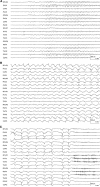Frequency and timing of nonconvulsive status epilepticus in comatose post-cardiac arrest subjects treated with hypothermia
- PMID: 21638118
- PMCID: PMC3188346
- DOI: 10.1007/s12028-011-9565-0
Frequency and timing of nonconvulsive status epilepticus in comatose post-cardiac arrest subjects treated with hypothermia
Abstract
Background: Therapeutic hypothermia (TH) improves outcomes in comatose patients resuscitated from cardiac arrest. However, nonconvulsive status epilepticus (NCSE) may cause persistent coma. The frequency and timing of NCSE after cardiac arrest is unknown.
Methods: Review of consecutive subjects treated with TH and receiving continuous EEG (cEEG) monitoring between 8/1/2009 and 11/16/2010. Demographic data, survival, and functional outcome were prospectively recorded. Each cEEG file was analyzed using standard definitions to define NCSE. Data were analyzed using descriptive and nonparametric statistics.
Results: Mean age of the 101 subjects was 57 years (SD 15) with most subjects being male (N = 55, 54%) and experiencing out-of-hospital cardiac arrest (N = 78; 77%). Ventricular fibrillation was the initial cardiac rhythm in 39 (38%). All subjects received TH. Thirty subjects (30%) awoke at a median of 41 h (IQR 30, 61) after cardiac arrest. A total of 29/30 (97%) subjects surviving to hospital discharge were awake. Median interval from arrest to placement of cEEG was 9 h (IQR 6, 12), at which time the mean temperature was 33.9°C. NCSE occurred in 12 (12%) subjects. In 3/12 (25%) subjects, NCSE was present when the cEEG recording began. In 4 subjects, NCSE occurred within 8 h of cEEG recording. One (8%) subject with NCSE survived in a vegetative state.
Conclusions: NCSE is common in comatose post-cardiac arrest subjects receiving TH. Most seizures occur within the first 8 h of cEEG recording and within the first 12 h after resuscitation from cardiac arrest. Outcomes are poor in those who experience NCSE.
Figures



References
-
- Hypothermia After Cardiac Arrest Study Group Mild therapeutic hypothermia to improve the neurologic outcome after cardiac arrest. N Engl J Med. 2002;346:549–56. - PubMed
-
- Bernard SA, Gray TW, Buist MD, et al. Treatment of comatose survivors of out-of-hospital cardiac arrest with induced hypothermia. N Engl J Med. 2002;346:557–63. - PubMed
-
- Sunde K, Pytte M, Jacobsen D, et al. Implementation of a standardized treatment protocol for post resuscitation care after outof-hospital cardiac arrest. Resuscitation. 2007;73:29–39. - PubMed
MeSH terms
Grants and funding
LinkOut - more resources
Full Text Sources
Medical

